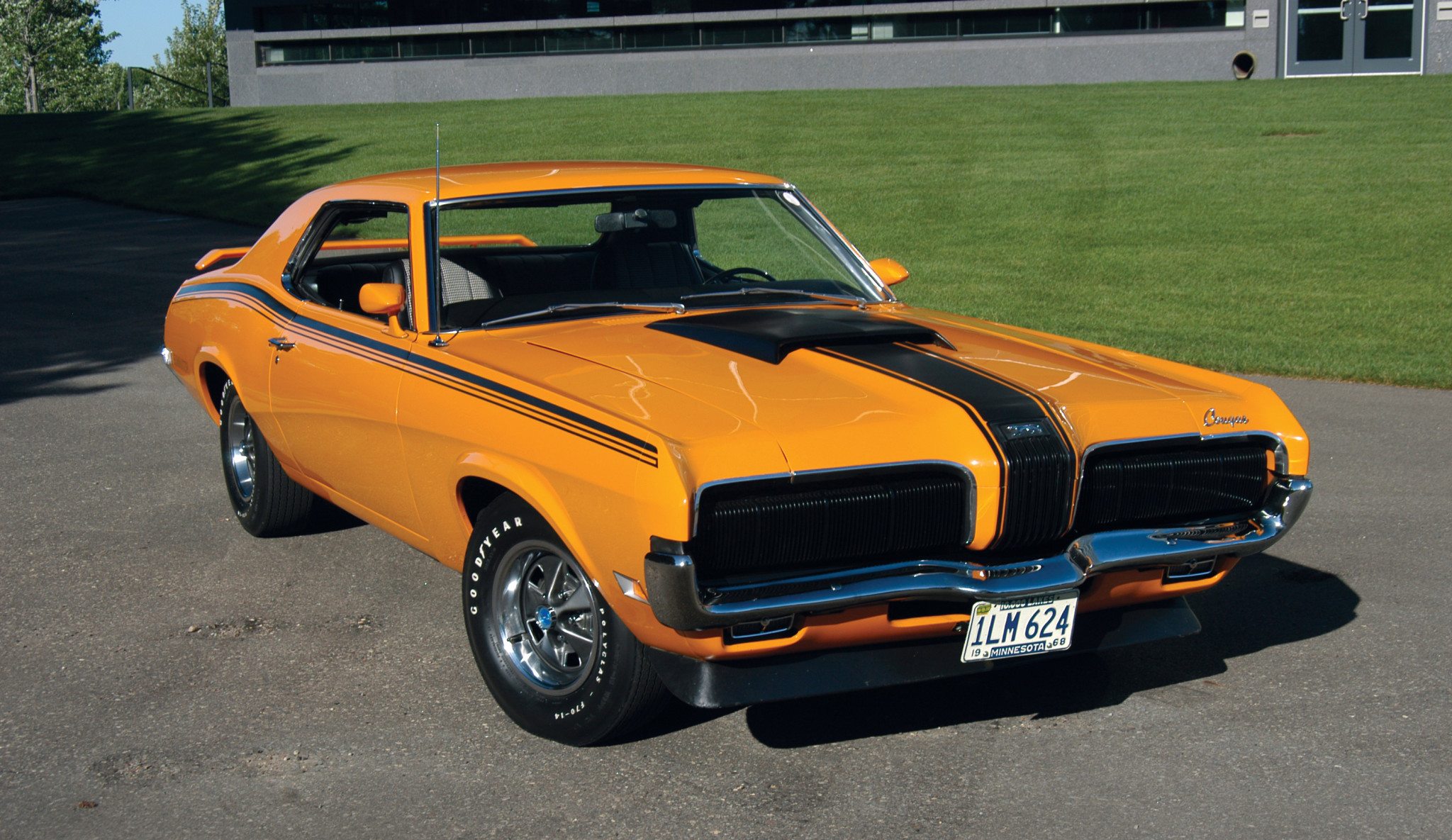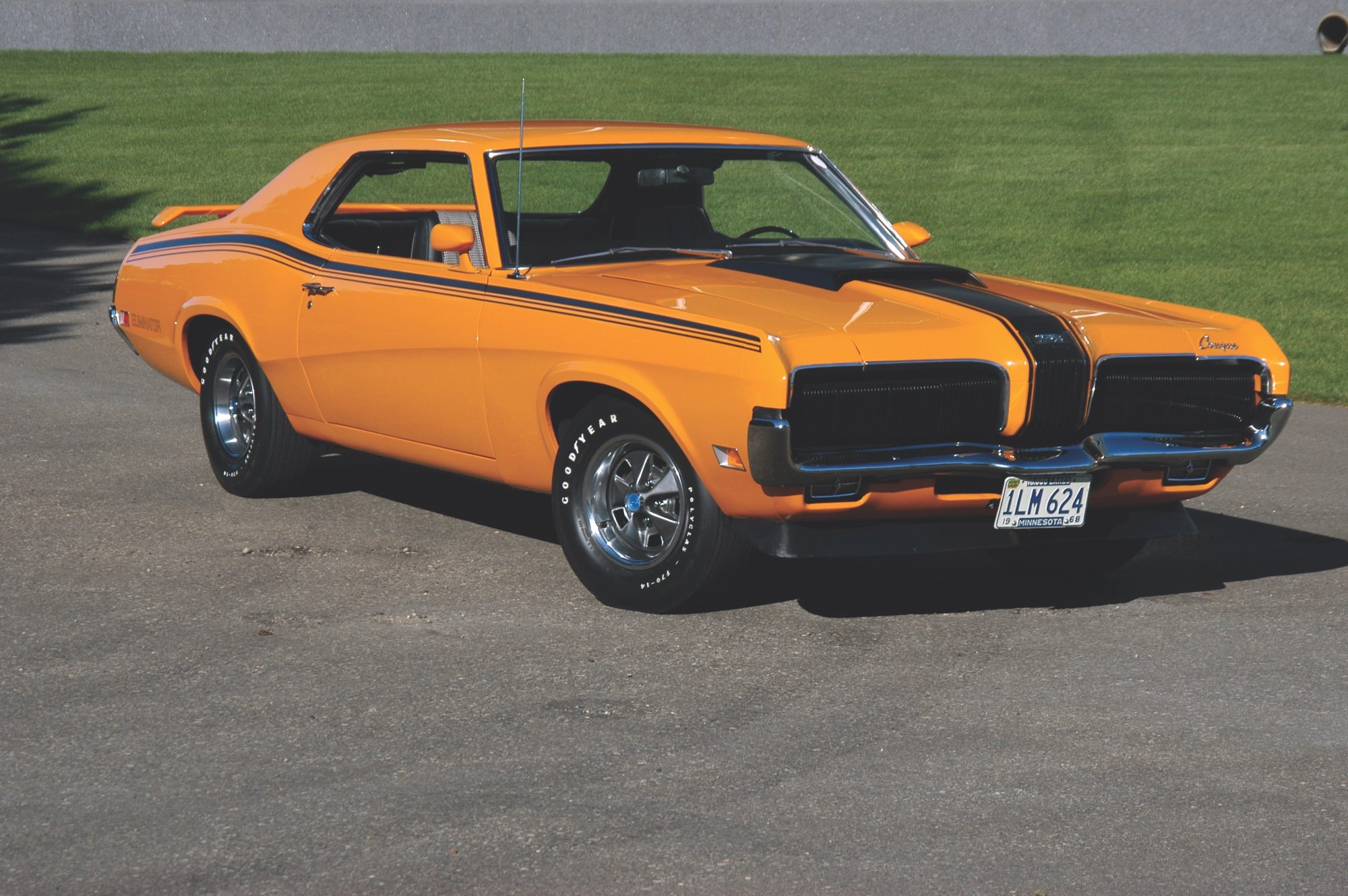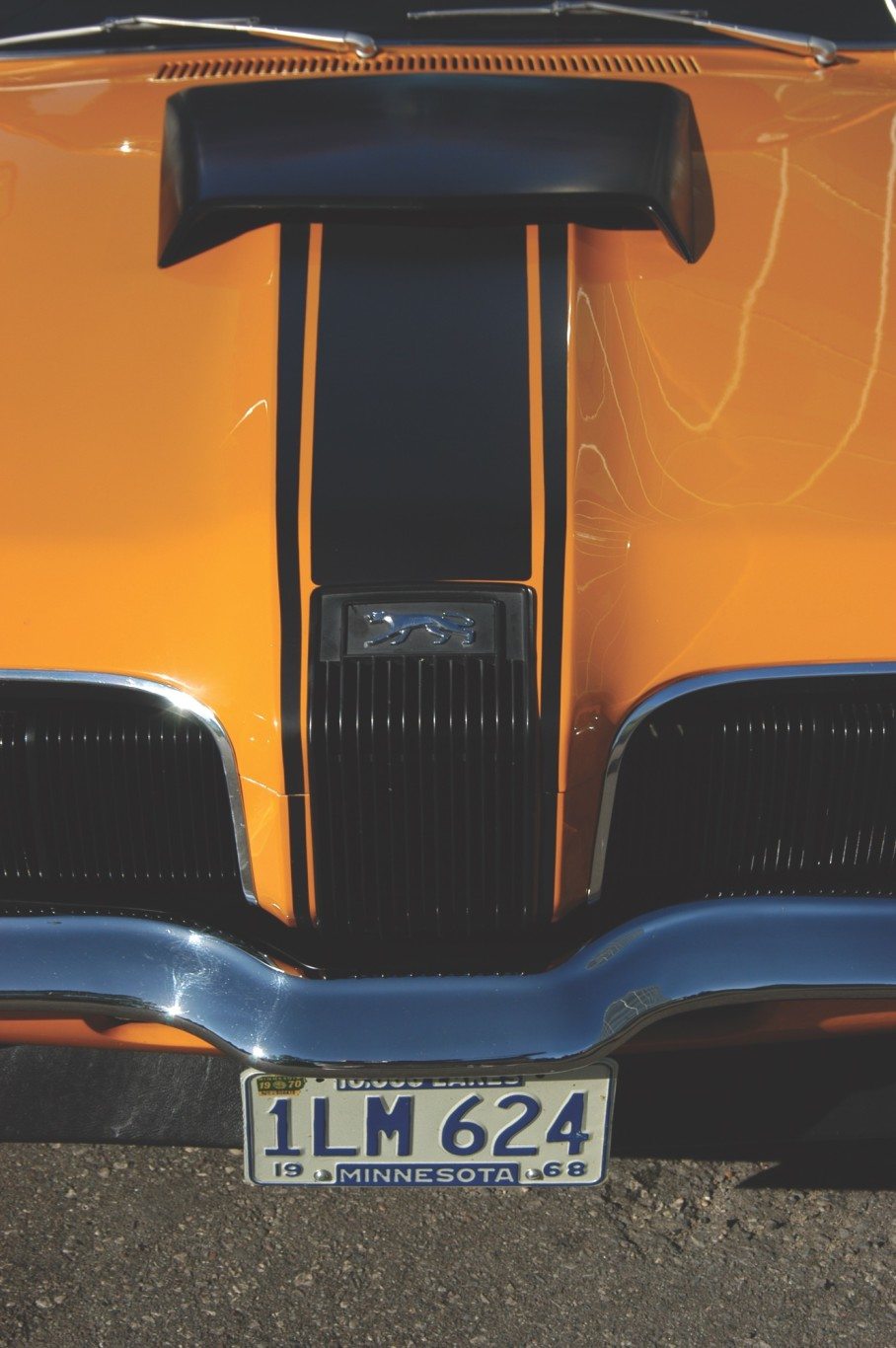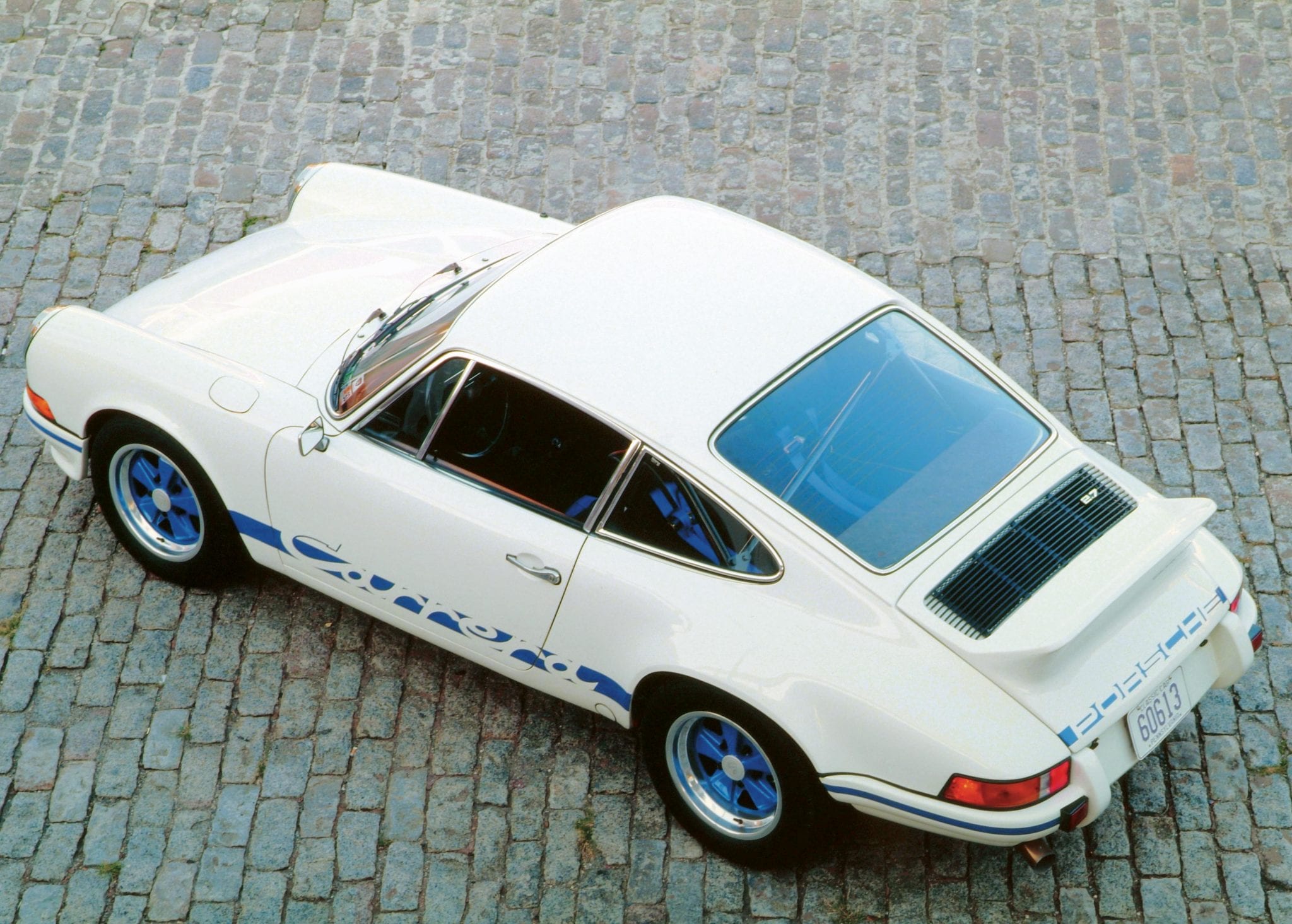
The 1970 Cougar Eliminator may not have been as popular as its Mach One Mustang cousin, but it was just as muscular.
One of the most unique automotive markets of the 1960s was the pony car segment. Named for the first of the breed, Ford’s 1964 ½ Mustang, the cars competing for consumer attention all had the same “long hood/short deck” profile established by the Mustang. At the height of the market, the pony car segment accounted for almost 10 percent of automotive sales. It was an important and lucrative part of Detroit’s product lineup. Consequently, every carmaker, except Cadillac and Lincoln, had fielded a pony car by the late 1960s. Aside from the Plymouth Barracuda, Ford owned the market until 1967 when Chevrolet and Pontiac launched Camaro and Firebird. It wasn’t only arch rival GM that entered the pony car wars in ’67, Ford management decided that corporate cousin Mercury should get a piece of the action as well.
That decision launched the Mercury Cougar – an upscale version of the Mustang that came standard with hidden headlamps and sequential tail lamps, more luxurious interior appointments and styling. Overall, Cougar shared virtually nothing with the Mustang. If the Ford model was the blue-collar sporty car, then Mercury’s pony car was a luxury GT touring machine. Its top of the line XR-7, introduced in mid-1967, offered wood grained instrument panels, upgraded upholstery, and four-speed gearbox. There was even a GT package that included a 320-horsepower 390 cubic inch engine with low restriction exhaust, power disc brakes, handling package and wide oval tires. Hardly what one would call a muscle car, but the GT was a nicely packaged performance car.

Mercury was reluctant to bulk up the Cougar and take on the muscle market, a place where rivals like the SS396 Camaro and Ram Air 400 Firebird had already begun staking territory. By 1969, the Mustang was knuckling against these two with its 428 Cobra Jet Mach 1, and Mercury could no longer sit on the sidelines. By mid-year, the division had jumped into the fray with the Eliminator. The name was taken from a Cougar show car and from the 1968 Cougar Eliminator funny car driven by “Dyno” Don Nicholson. Management fathomed that racing exposure could heighten Mercury’s profile with young performance buyers. They were the ones who drove the hot cars, right?
Dressed out in de rigueur bright colors, blacked out grilles, body stripes, spoilers and decals, the Eliminator was based on the standard Cougar and came with a choice of engines from mild to wild. The standard block was a 351 cid V8 producing 290 horsepower @ 4800 rpm. Engine options ranged from the high revving Boss 302 to a pair of heavy breathing 428 cubic inch Cobra Jets, with or without ram air induction (both producing 335 horsepower @ 5200 rpm), and the old reliable 390, now in its final year, producing 320 horsepower @ 4600 rpm. Sales were small, only 2,250 were produced during the remainder of the 1969 model year.

Mercury turned up the heat for 1970. Standard engine was the 351 four-barrel V8 (either Windsor or Cleveland, depending on availability). The 351 Cleveland was the more desirable of the two, thanks to its canted valve positioning that permitted better cylinder flow. The Windsor was rated at 290 horsepower @ 4800 rpm and the Cleveland at 300 @ 5400 rpm). Also standard was a 3.25:1 rear axle and a performance handling package with F70x14 white lettered tires.

The Boss 302 engine could also be checked off on an order sheet. This was the same engine as in the Boss 302 Mustang with an output of 290 horsepower @ 5800 rpm. Top of the heap was the Cobra Jet 428 that produced 335 horsepower @ 5200 rpm. The cold air package Cobra Jet was rated the same as the non-ram air CJ. At least one Eliminator was equipped with the Boss 429 engine that was installed in a limited run of Mustangs to homologate the engine for NASCAR racing. With any engine choice, a floor mounted three-speed manual transmission was standard. The C6 automatic or a four-speed manual box was optional.
The Eliminator’s interior was offered in 10 different colors for 1970, up from seven the year before. Buyers had a choice of standard vinyl, Comfort-Weave vinyl or a black vinyl with white houndstooth check. Also standard for the Eliminator were high back bucket seats, black grain instrument panel, 6,000-rpm tach (8,000 for Boss 302 equipped models), a novel “elapsed time” clock and full instrumentation. For manual transmission cars, a Hurst shifter with aluminum “T” handle was standard, while automatic transmission models received a simulated wood grain shift knob (when the floor mounted transmission was ordered).
The exterior was modified for 1970 with the Eliminator’s grilles blacked out and a black center stripe running from the grille split, up the center of the hood into the blacked out hood scoop. Below the front bumper was a full-length black fiberglass chin spoiler. Along the upper beltline, a trio of stripes reached from the front fender to the end of the quarter. The standard dual outside rear view mirrors also sported a racing style look. Next to the rear side marker lamp was an “ELIMINATOR” decal on either side. On the deck lid was the usual muscle car stand up wing, this one carrying a stripe with ELMINATOR in the center and painted body color. Like other cars with the weighty deck lid spoiler, a heavier torque rod was required with the hinges to keep the lid open and not come falling down to crack the owner in the head. The tail lamp surround was also blacked out to add emphasis.
While the Eliminator had all the right stuff to qualify it as a muscle car (or a muscular pony car?), what it lacked was image. Image wasn’t built by painting on graphics or spraying on loud paint schemes. Image was earned every Saturday night on the streets of America from Woodward Avenue in Detroit to Van Nuys Boulevard in Southern California. It was established by how many lengths you could beat the next guy to the next light, or at the local drag strip winning your class for Top Eliminator. This was Mustang, Camaro, Firebird, and ’Cuda territory, and on a lucky night, a really lucky night, an AMX or two. That was the Eliminator’s problem.

Mercury’s top pony car had the right name but not the image. No one had to apologize for the hardware; there just wasn’t enough respect for a hotted up Cougar, even though Super Cars magazine tested an Eliminator 428 CJ with four-speed transmission and clipped the quarter in 14.4 at 99.88 mph and recorded a 0 – 60 time of 7.2 seconds. Compare that with the 1970 ½ Pontiac Trans Am with its 400 Ram Air engine rated at 345 horsepower, which ran the quarter in 14.1 seconds at 103.2 mph as tested by Car & Driver magazine with a 0 – 60 time of 5.7 seconds. Even the AMX with a 402 cubic inch engine rated at 325 horsepower did the quarter mile in 14.46 and 95.61, as tested by Super Stock & Drag Illustrated in September 1970. All these numbers indicated the Eliminator was a decent performer, but it didn’t have the image to muscle in on the market. The public agreed, turning out for just 2,267 Eliminators in 1970. The upscale XR-7 model faired much better, selling 33,946 copies.
The 1970 Eliminator was Mercury’s last attempt at total performance with the Cougar. After that, the 1971 Cougar was restyled into the image of a pocket Thunderbird with the emphasis on luxury. To underscore this opulent image, in model year 1971, 97 percent of all Cougars were equipped with automatic transmissions, 75 percent had air conditioning, 80 percent had front disc brakes and 78 percent had tinted glass. If the saying “water finds its own level” is a truism, then it’s safe to say the Cougar found its level in the personal luxury market. It was a market the Cat would successfully survive in for many years.
The Competition Gold 1970 Cougar Eliminator shown here is one of the best in the country. Greg Fritz purchased it in September 2004 from Bill Quay, the head judge for the Cougar Club of America. Quay had completely restored the car in 1980 using as many NOS parts as possible. For the next 24 years, he showed the Eliminator and with this car helped to establish the exacting judging standards the CCOA is known for.
While the Eliminator is superbly preserved, Greg isn’t afraid to stretch its legs in Ramsey, Minn., between May and October, before the snow starts to fly. This past June he drove it to the SAAC Midwest Meet in Tulsa, Okla., bolted on the racing tires and ceramic disk pads for some hot laps at Hallett road course. Greg then cruised over to the drag strip and picked up a 14.58/97 mph. From there, he cleaned the Eliminator up and entered it in the Sunday show at the SAAC meet and took home a First Place in the Cougar class.
Greg’s Eliminator is very well equipped with the 428 Cobra Jet with ram air, power steering, power disc brakes, styled steel wheels and four-speed gearbox with 3.50:1 Traction Lok rear. The excellent original Black houndstooth interior is testament to the low 66,000 miles on the car and features an AM radio and sports console. It’s difficult to determine how many 1970 Eliminators are left today, but it’s not hard to deduce that Greg’s is one of the finest.
by Paul Zazarine
© Car Collector Magazine, LLC.
(Click for more Car Collector Magazine articles)
Originally appeared in the March 2007 issue
If you have an early model Mercury or another collectible you’d like to insure with us, let us show you how we are more than just another collector vehicle insurance company. We want to protect your passion! Click below for an online quote, or give us a call at 800.678.5173.





Leave A Comment